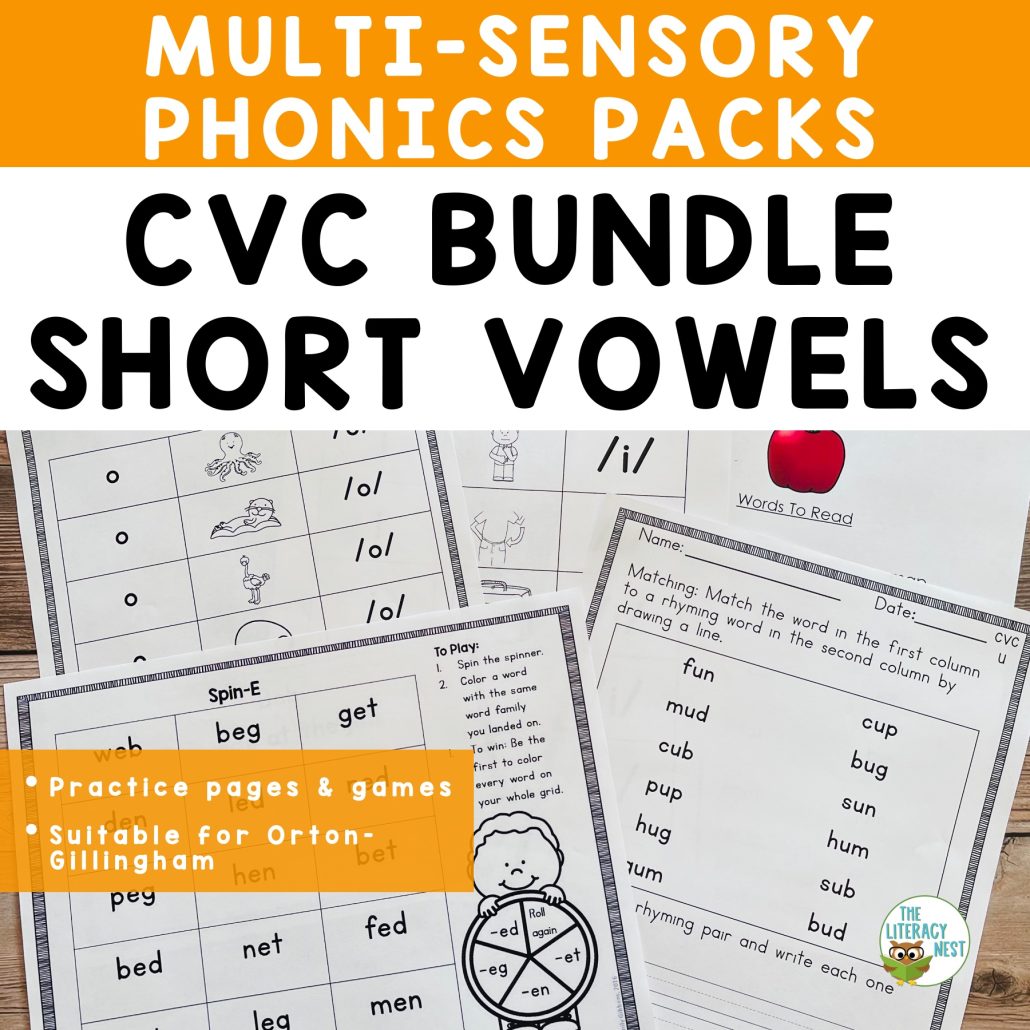7 Tips to Help Your Student Master Short Vowel Sounds: Tricky Short I and Short E!

One of the very first things students need to master happens to be one of the most difficult for many of them: the short vowel sounds. Short vowels are introduced very early in level one of an Orton-Gillingham lesson plan or with any reading intervention program for that matter.
While every student is different, probably the most difficult distinction for many struggling readers is between the short e and short i sound. It is useful to note that some children similarly struggle with short i and a. These same general tips will apply.
Tricky Short I and Short E Sounds!
Below you will find seven simple tips to help your students master these tricky short vowel sounds!
Download our printable short vowel sound tipsheet!
1. Divide and Conquer:
Try not to teach these two phonemes back to back. It is often best to separate the introduction of short vowel sounds that weren’t previously mastered by several review lessons or lessons covering other concepts. By separating the introduction of these easily confusable sounds, students can gain proficiency with one before muddying the waters with a 2nd sound.
2. Use a Mirror and All Their Senses:
Have the child use a mirror to learn how their mouth looks and feels when saying the sounds, as well as learning the sound it makes. “I make you grin, E drops your chin” is a great verbal reminder. When making the short I sound, the student’s teeth are typically very close together, perhaps only enough to fit a fingernail in between. The corners of the mouth are pulled back in a smile. When making the short e sound, the chin drops slightly, the mouth opens a bit more, about enough to fit the tip of one finger, and the corners of the mouth relax.
Try this cool multisensory approach! Watch Paint Tray Ideas for OG Lessons, Part 1: Speech-to-print, Morphemes, and Graphemes.
3. Keywords Matter:
It is very important with any short vowel sound to use a keyword that is easily distinguishable and in which the targeted sound is easily heard and identified. Often these are NOT the words that appear on commercially designed alphabet strips, flashcards, and phonics materials.
This is particularly important when dealing with students with regional accents. Short I is easily heard with the keyword itch or itchy. Avoid words like igloo (often pronounced “eegloo”) or words in which the vowel sound is in the medial position like pig. For the short e sound, edge or Ed works very well as a keyword. Avoid words like egg (often pronounced “ay-g”) or elephant (the e can be very tricky to separate from the l sound). I have found it helpful to make use of materials that used elephant by renaming him “Ed the Elephant”.
4. Pronunciation Matters:
It is very important to make sure that the teacher, volunteers, and any helpers are pronouncing the vowel sounds correctly. In addition to making sure the child can hear the difference, make sure the child is also saying the sounds correctly. This will prove very important when the time comes for spelling words with short vowels i and e.
When initially learning short vowel sounds, avoid words ending in n and m as they can somewhat distort the short vowel sound. Later in the learning sequence, begin to include words ending in n and m as well. Articulate the word very clearly for writing. It is important to be aware of how your regional accent or the accent of your student may have an impact on pronunciation and make distinguishing between these two sounds more difficult.
5. Lots and Lots of Listening:
Mastering the short vowels is not just a matter of training students to see a letter and say that sound, but training their ears to distinguish these different sounds. Doing lots of phonemic awareness activities such as picture sorts with words that contain the targeted vowel sounds is a great center or even direct instructional activity. Using vowel sticks can enable an entire class to participate in choosing between 2 or 3 or even more vowel sounds in response to a teacher prompt such as a word, picture, or sound. This is both a practice activity and a simple check for the teacher regarding which children may be struggling with this concept.
6. Use Hand Signals:
You may find yourself doing this unconsciously when a child makes an error with a vowel sound, but a hand signal is often an additional layer of support that allows us to prompt or correct a child without providing the sound for them. For example, moving your finger in a circle around the mouth for the short o sound, or pointing to the corner of the mouth for the short i. This is also a really helpful tool for times when your student might feel uncomfortable with more obvious help.
7. Practice Makes Permanent:
Short vowel sounds are, perhaps more than any other skill, not a teach-it-and-forget-it matter. Extensive targeted practice, occasional reteaching, and lots and lots of reviews and reminders are necessary. Utilizing multiple strategies such as a mirror, using strong keywords to remind students of correct vowel sounds, and playing review games are all winning strategies. Fly swatter games (students slap the right word or picture based on the targeted sound or using a double-sided fly swatter), board games, and card games such as Uno or Go Fish that ask students to identify the letter, match the sound, read or spell words are all excellent practice.
Need more support helping your students with short vowel sounds? Read Top Tips for Helping Children Distinguish Between Short and Long Vowel Sounds!
Mastering these foundational basic skills is essential to the continuing development of a child’s reading and writing skills. I have noticed that oftentimes, older students who struggle with reading and writing lack proficiency in phonemic awareness skills and short vowel sounds but can hide it due to their visual memory or other strengths. For older students, it is important to take into consideration their large sight vocabulary of CVC words. Utilizing nonsense words (or single syllables from longer words) with these same strategies can ensure that this crucial skill is mastered.
CVC Games: Short Vowel Sounds
CVC words are some of the first and most common words in the English language that young readers learn to read. Using a multisensory approach to teach CVC words, like CVC games, will ensure reading success and comprehension for your students.
This multisensory CVC games phonetic bundle is suitable for reading intervention, the Orton-Gillingham approach, distance learning, online tutoring, or other structured literacy programs. It is compatible with Orton-Gillingham Level 1.
You can grab it at The Literacy Nest Shop.
Are you looking for a list of words to use in your short vowel sound lessons? Word List Builder has got you covered!
Save time searching for short i and short e words! Create customized and meaningful review, build your folder of words, create templates and games, and much more in Word List Builder.










Great tips, Thanks! Funny though, my OG training from IMSE as well as the resources they provided us with have igloo as the I key word, an igloo is on the vowel intensive cards, the card decks, etc…
Igloo is a common key word. In my training, we were taught to use itch or itchy for short i. Personally, I find that to be a cleaner short i sound than igloo. Thanks for reading!